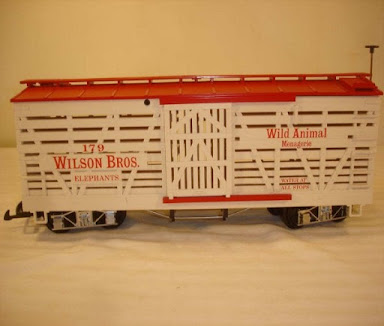The next car to arrive at customers doors was the LGB 3084 DG Advertising Car
 |
| LGB 3084 Advertising Car - Courtesy of liveauction.com |
The car was US$ 119.99 and shipped somewhere in spring of 1994. A few months later came the LGB 4068 Elephant Car
 |
| LGB 4068 Elephant Car - Courtesy of liveauctions.com |
Next car was the LGB 4269 DG flat car orange with handcrafted circus tableau wagon
 |
| LGB 4260 DG with handcrafted flat car, tableau wagon by Columbine Hobby Co Courtesy of Reynaulds.com |
That concluded the deliveries for 1994.
In 1995 Jim had two more items to deliver: the wonderful LGB 4075 DG Caboose for US$ 139.00
 |
| LGB 4075 DG Caboose - Courtesy of liveauctions.com |
and the "cherry on the cake " Circus loco LGB Mogul 22191, US$ 599.00
 |
| LGB 22191 Mogul - Courtesy of BigTrainWorld.com |
With that by the summer's end of 1995 the avid LGB collector was now the owner of this train set:
22191 Wilson Bros. 2-6-0 Steam Engine
3084 DG Advertising Car-Red
3180 DG Passenger Car-Green
3181 DG Colossal Combine Car
4060 DG Flat Car, blue
4067 DG Tent & supply car, orange
4068 DG Elephant stock car, white w/red trim
4075 DG Caboose, red & yellow
4080 DG Water car, silver & green
4160 DG Flat Car, yellow
4260 DG Flat Car, orange
4360 DG Flat car,silver 4360-DG Flat Car-Silver
1-Die Cast 1931 Model Sixty Diesel Caterpillar with Metal Tracks,(RARE)
3 hand crafted circus wagon by Columbine Hobby Co.
Unfortunately very few complete collections did survive. Most often the collection was torn apart either into separate items to be sold or the cute handmade circus cars and the wonderful die cast tractor ended up in some kids playground never to be found again... However one such COMPLETE Wilson Bros Circus set was just currently for sale at Only Trains/Minnesota for a decent US$ 1,000.00
And Jim Marski? He lived happily ever after in Colorado. He's still there dabbling in consulting and enjoying his life - thanks to a great LGB business idea at the right time in history.






























